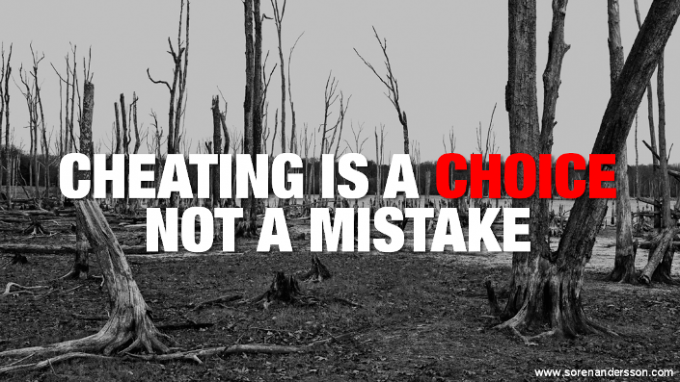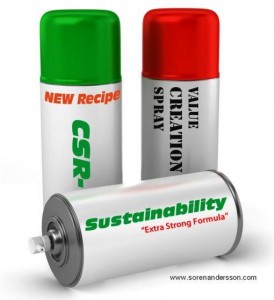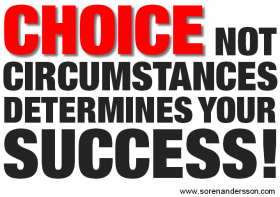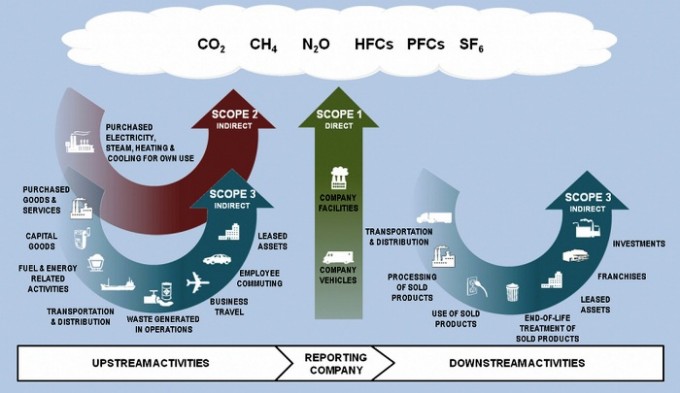
I bet you have seen them – Corporations that believe Sustainability only needs to be added to Business-as-usual like an adhesive sticker… believing that if they only can be perceived as Sustainable, its “Good Enough” – it will give them respite to continue as usual….
… and your reaction to this?
Let’s take a look at some rather common practices – please help me determine whether they should be on the “Sustainability Cheat-Sheet”…
Add-on duty…
Is this maybe one of the most common approaches…?
“…Someone realizes that the company needs to make some kind of Sustainability or CSR-commitment. A Sustainability-policy or vision is drafted, often together with the PR-department. This ‘vision’ is then published on the homepage and through various channels. Sometimes the ‘vision’ is also accompanied by some additional information and maybe even some presentations“
 Then the whole organisation is supposed to solve this “Sustainability-thing” as an add-on, often without interfering with or affecting other existing processes too much, and especially without affecting economic structures and key-figures in any negative way.
Then the whole organisation is supposed to solve this “Sustainability-thing” as an add-on, often without interfering with or affecting other existing processes too much, and especially without affecting economic structures and key-figures in any negative way.
Responsibility is with this approach sort of “spray-painted” on the whole organisation while managers and executives get a great deal of deniability – “it’s all written in the official Policy, available for all…”
In a previous post on “Cheating” are some links to articles and reports on how “poorly” policy’s are integrated into the “heart of operations”…
… I have always envisioned leaders as the ones creating visions and strategies, and managers as executors, making sure that visions and strategies are integrated into operations – apparently I was wrong, “Talk-the-Talk” or even a “Spray-can” seems to be good enough these days…
Diversion…
This is probably one of the oldest “tricks” in the book – every magician or “con-artist” uses it and if you read about Alexander the Great, Napoleon or Sun Tzu you are likely to find examples of it in their strategies.
 A typical example of a diversion is to engage in a community project. Find some project, preferably a project with “human values” or a project that in some way can draw “empathy” from bystanders and the public and where the corporation can be a sponsor, preferably not only with money but also through cooperation and involvement in other ways.
A typical example of a diversion is to engage in a community project. Find some project, preferably a project with “human values” or a project that in some way can draw “empathy” from bystanders and the public and where the corporation can be a sponsor, preferably not only with money but also through cooperation and involvement in other ways.
Then include storytelling from this project in corporate marketing… often this is called “cause marketing”.
This has little to do with a Corporation running a Sustainable business, it’s an act of philanthropy or charity, and deserves of course to be acknowledged as such.
A typical example is probably the way Walmart engage in “Philanthropy projects” while at the same time paying so low wages that some employees have to rely on Tax funded social security to “Survive”…
… Sustainable Business and Philanthropy can exist parallel or even co-exist, but Philanthropy can never replace a Sustainable Business…
Avoid Upstream and Downstream…
Only reporting what you yourself consider important, isn’t that a pretty “smart” way to Cheat?
… the other day I read about a recent election in a “Northern Asian country” where 100% of the citizens voted and 100% of them voted for the same guy – at least that was what he reported….
When reviewing a corporations “level of Sustainability” and especially emissions you will inevitable come across the terms “Scope 1, 2 and 3” – schematically described below.
Most certification schemes such as Global Reporting Initiative (GRI) focuses mainly on the reporting company’s “own activities” – equal to Scope 1 and 2.
Also in cases of official or even legally demanded reporting of Sustainability Key-indicators, Scope 1 and 2 are normally considered mandatory, while scope 3 is often voluntary.
What does this mean in reality?
Let’s look at an investment bank – Their office is located downtown directly on a communication-hub, the small fleet of company cars run on biogas, the office is built according to high environmental standards, LEED Platinum certified, all energy used is renewable from solar panels on the roof, all systems for equality, diversity etc. are in place – according to GRI the company scores very high points.
Does this make the Investment Bank a Sustainable company?
…What if this investment banks main activity is to raise funding for Tar Sands projects in Canada, Oil exploration in the Arctic or if it deals with money transfer operations through a “Double Irish With A Dutch Sandwich” scheme – still Sustainable…?
Avoiding upstream and downstream activities (Scope 3) is a very common way to “Cheat” – in fact it’s even worse, it is “System-supported Cheating”…
According to Bob Willards recent article in Toronto Sustainable Speaker Series (TSSS), the January 2014 Global 100 ranking of the world’s 100 most sustainable large publically traded companies included ten oil and gas companies [?]. The December 2013 Climate Counts rankings of corporations with the most sustainable carbon emissions included five oil and gas companies [?]…
This is ridiculous – it turns Sustainability-reporting into a farce…
Marketing…
Anything can be “sold” with good marketing – Sustainability is no exception…
One of the tricks often used is to create a corporate message and slogans including an “ambiguous” wording, with respect to Sustainability – a “wording”, that can be perceived and used in various ways. A couple of examples, from “Sustainability-focused” communication:
“…with this fashionably thinner bottle that has 15% less plastic we can all make a difference…”
Less plastic than what – does this mean that bottled water all of a sudden is OK and should be bought by more people… make a difference, to what – destroying the world a “little less”, increasing the purchase of bottled water…
“…the Community Builder…”
Is this really about building a “Community”, or is it about “Building stuff” in the community – two very different messages, same words…
Another approach is to associate unsustainable commercial messages with pictures of something totally different – misleading the bystanders impression.
 In this example a message about 15,000 m2 more Shopping-area to be built, printed on a green background and associated with an innocent child playing with dandelions on a summer meadow…
In this example a message about 15,000 m2 more Shopping-area to be built, printed on a green background and associated with an innocent child playing with dandelions on a summer meadow…
More excessive Consumerism, being one of the main causes to the exploitation and “destruction” of our planet, doesn’t create more summer meadows, it is instead seriously jeopardizing the future for this innocent child…
…our survival on this planet depends on whether we as a Society can seriously understand and take on the enormous challenge we are up for – using marketing to deliberately mislead or misinform people on this very complex matter is not only unethical – it’s a betrayal of our children and future generations…
Trapped by circumstances…
This is a cheat where corporations downplay their own role and/or transfer blame on someone else, not seldom using sweeping statements. The underlying reasons can be many, generalizing a bit, you could say that somehow the corporation have decided it is not worth the effort for some reason…
”…We really want to produce more low-energy houses but our customers are not asking for it…”
“...We really want to produce cars with better fuel economy, if our customers asked for it…”
 This is equal to Apple saying “We really would like to produce an iPhone with a camera in it, if only the customers would ask us to” – We all know how that one went…
This is equal to Apple saying “We really would like to produce an iPhone with a camera in it, if only the customers would ask us to” – We all know how that one went…
A “Trapped by circumstances” approach is often a signal that the corporation don’t want to change, either because the profits from Business-as-usual is Good Enough or they are lacking capacity to change or even the ability to innovate…
There could of course be yet another reason – it takes less effort to just continue “the way it is”…
Reflection
When writing this article I realized that there are many more examples of Cheating out there than I could possibly fit into an article.
I truly wonder why Corporations choose to spend so much time, money and effort to Cheat on Sustainability – why not spend it on Real change instead…
“Why wouldn’t we want to have a positive impact on the world?”
